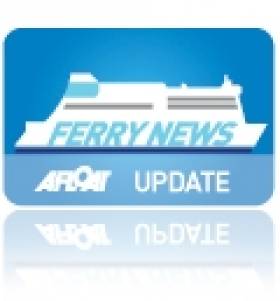Displaying items by tag: Mersey Ferries
Mersey Ferry to Celebrate The Beatles
#FERRY MUSIC – The famous 'ferry cross the Mersey' service operated by Mersey Ferries, are to run River Shuffle Cruises in honour of the 50th anniversary of The Beatles last performance aboard the Royal Iris.
The special two-hour cruises are part of the Riverboat Shuffle Music Festival (22-30 September) which celebrates Liverpools' most music and culture.
For a list of The Riverboat Shuffle Cruises (and evening performances) see the ferry website. All of the cruises cost £10 and on board there will be a full bar service available as they depart from both sides of the Mersey. For a list of the cruises and sailing times, click HERE.
Stena to Close Larne-Fleetwood Route
The route has made significant losses over recent years and to running an aging fleet on the 7-hour service. Stena cite that investment in new tonnage was not an option due to higher capitol costs. "No business can continue to carry such losses on an ongoing basis so there is no alternative but to close the route at the end of this year," he added.
The trio of vessels, Stena Leader (1975/12,879grt), Stena Pioneer (1975/14,426grt) and Stena Seafarer (1975/10,957grt) serve the link between Lancashire and Northern Ireland which takes freight, cars and their passengers but does not cater for 'foot' passengers.
Late last month a fire took place in the engine room of the Stena Pioneer during a sailing to Fleetwood, the fire was extinguished using onboard equipment and fortunately without incident to crew or passengers.The Stena Pioneer was operated by B&I Line as their Bison in a joint service with Pandoro on the Dublin-Liverpool route between 1989-1993.
Under the new agreement, Stena Line's take-over of Belfast-Heysham, the port is a close neighbour to Fleetwood will include the 13,000 tonnes sisters Hibernia Seaways and Scotia Seaways.The other route aquired is Belfast-Birkenhead (Liverpool) which is significant in that the deal will include the purchase of the chartered 27,000 gross tonnes ro-pax twins, Mersey Seaways and Lagan Seaways. The sisters were built in 2005 at the Visentini shipyard, Italy, which also built the ro-pax sisters Dublin Seaways and Liverpool Seaways.
Measuring 21,000 gross tonnes these vessels operate Dublin-Birkenhead route but remain under DFDS Seaways control and this applies to their freight-only service from the Irish capital to Heysham served by the Anglia Seaways. The 120-trailer freight ferry is also a sister of the Belfast-Heysham pair.
Notably the transaction will see Stena Line enter operations on the Mersey for the first time.The Swedish operator will use the river's Birkenhead Twelve Quays ferryport terminal located on the Wirral, opposite the famous Liverpool waterfront.
Stena Line will not only share the double berth facility with DFDS Seaways but also the Isle of Man Steam Packet (IOMSPCo) which in recent years has operated winter sailings to Douglas. In the summer the Isle of Man ferry operator uses the Liverpool landing stage berth on the other side of the river which is also shared by the 'ferry cross the Mersey' fleet operated by Mersey Ferries.
Liverpool FC Face Another Battle...of the Ferries!
Supporters of each team will board the famous 'Ferry cross the Mersey' on a combined cruise and race event of approximately 1.5 hours. The ferries will be adorned in the Royal Blue of Everton
and Red of Liverpool and 'skippered' by two icons of Merseyside football. Liverpool's stricker Ian St John will join fans onboard Royal Iris of the Mersey while onboard Snowdrop, Everton supporters will be accompanied by former midfielder Ian Snodin.
The 'football-ferries' will race on a predetermined course, followed by a victory lap and then disembark supporters at the ferry terminals: Seacombe, Woodside and Liverpool Pier Head. The charity ferry race event is in association with Merseysidetravel, Soccerbus and Radio City.
For further information on sailing times, ticket sales and booking enquiries contact Mersey Ferries, Tel: 00 44 (0)151 330 1444 (Monday - Friday 9.00am - 4.30pm) and www.merseyferries.co.uk
























